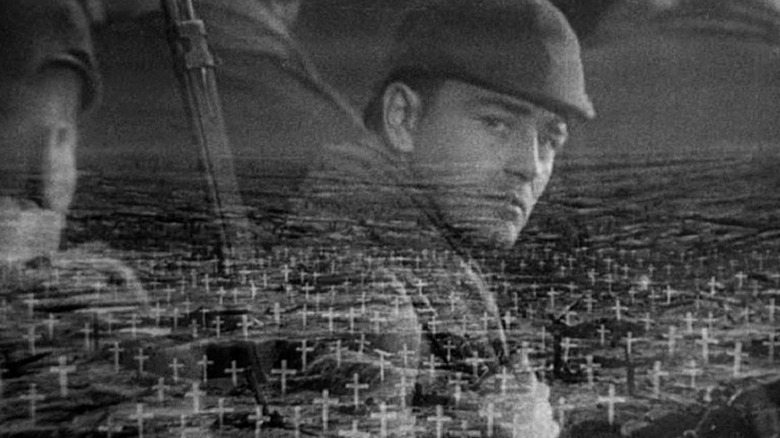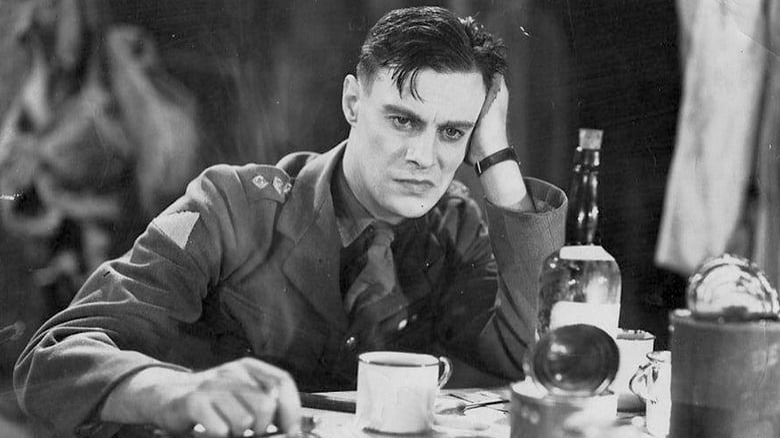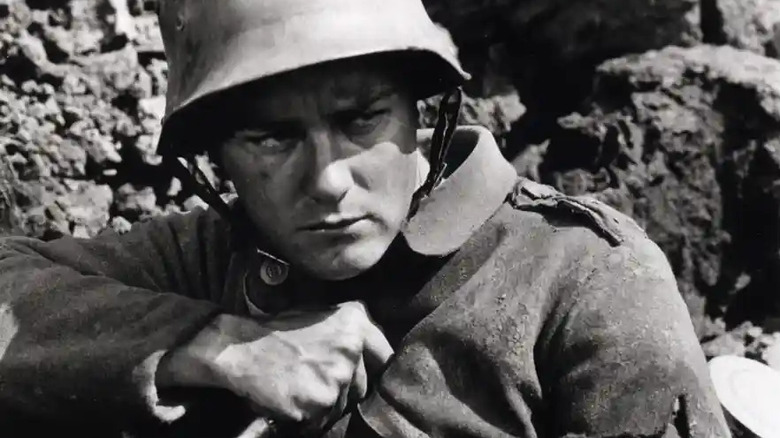Before Dracula, Universal Studios Was Famous For A Different Nightmare: War
Although Universal had struck on big hits with "The Hunchback of Notre Dame" in 1923 and "The Phantom of the Opera" in 1925, studio honcho Carl Laemmle, Sr. was no fan of the horror genre. It was his monster-obsessed son, Carl Laemmle, Jr., that encouraged the studio to adapt the then-popular stage production of "Dracula" to film. The movie, released in 1931 and directed by Tod Browning, was stagey and nightmarish, and it deeply burned itself into the collective unconscious. Bela Lugosi, as Dracula, taught the world how vampires behave.
"Dracula" was one of Universal's biggest hits, and Carl Jr. knew that multiple more monster projects could be instantly pushed into the pipeline. The 1930s saw the release of "Frankenstein," "Dracula's Daughter," "The Invisible Man," "Bride of Frankenstein," "The Black Cat," "The Invisible Ray," "Werewolf of London," "The Raven," and scads of others. Horror became the studio's niche.
The wave of popular horror films at Universal, however interrupted a strategy that Carl Sr. had just implemented: war pictures.
Great War films had already been popular since the 1920s — the Treaty of Versailles was signed in 1919 — and cinemas regularly saw exciting scenes of aerial combat, reenacting the conflict's dogfights. Rather than being films of jingoistic propaganda, however, World War I movies tended to be critical of the war as popular perceptions had been skewing downward since its conclusion. The 1920s were marked by the release of two notable war pictures: King Vidor's 1925 film "The Big Parade," released by MGM, and William Wellman's 1927 film "Wings," released by Paramount. There weren't yet Oscars in 1925, but "Wings" famously won one of the two inaugural Best Picture winners ("Wings" won "Outstanding Picture," while F.W. Murnau's "Sunrise: A Song of Two Humans" won "Best Artistic Picture").
Journey's End
Eager to cash in on the rising popularity of Great War films, and happy to fall in line with popular critical receptions of the conflict, Universal put a few high-profile anti-combat films into production. Released in April of 1930, "Journey's End" was directed by James Whale ("Frankenstein") and starred Colin Clive (also "Frankenstein"). Set in 1918, "Journey's End" followed a young, eager soldier named Raleigh (David Manners) who was eager to rush to the front and fight alongside a school chum named Stanhope (Clive) who had enlisted years previous. When the two men reunite, Raleigh finds Stanhope a broken man, driven to drink by war and unhappy with his lot. Stanhope's only solace is imagining returning home and romancing Raleigh's sister.
The central drama of the film involves protecting Stanhope from losing his mind entirely as bombs continue to fall. "Journey's End," like many war pictures of the time, does not glorify combat or romanticize the soldier's experience. The trenches, Whale seems to argue, are dour places full of misery. Those who only know Clive for "Frankenstein" would do well to see his range in "Journey's End."
A fun bit of trivia: "Journey's End" was the second film Whale worked on as a director, but it was the first that was released. Whale was famously hired by Howard Hughes to help transform the millionaire's silent dogfight movie "Hell's Angels" into a talkie (a drama reenacted in Martin Scorsese's "The Aviator"). Hughes took so long on his film's post-production that Whale was able to direct and release "Journey's End" a week before "Hell's Angels" came out. This story is told in the 1998 book "James Whale: A New World of Gods and Monsters" by James Curtis.
All Quiet on the Western Front
The bigger 1930 Universal war hit, however, was Lewis Milestone's "All Quiet on the Western Front," perhaps — without hyperbole — one of the best movies ever made. "All Quiet" was adapted from the celebrated 1926 novel by Erich Maria Remarque, and told the story of Paul Bäumer (Lew Ayers) enthusiastically enlisting for combat at age 17, only to find — like in "Journey's End" — that life in the trenches is essentially Hell. Paul is unprepared for the death and pain and gore that only large-scale conflict can create, and soon becomes just as jaded and hollowed out as some of the older soldiers he spends time with. "Older solders," in this case, means maybe 21 or 22.
The film ends with Paul retuning home, a ghost of his former self. He wanders into a classroom where a teacher is attempting to recruit a new generation of potential soldiers. Paul rants about how awful the world is thanks to combat. In the film's penetrating final shot, young soldiers march off to battle. The image fades to a battlefield littered with gravestones. War begets death and nothing else. "All Quiet on the Western Front" is one of the few films that never once makes combat seems exhilarating or the soldiers' experience to be nostalgic. It is one of the better works of antiwar cinema.
"All Quiet" won the Academy Award for Best Picture, and Milestone won for Best Director.
Given the one-two punch of Universal's 1930 war pictures, there was every reason to believe the trend would continue. Perhaps genre movies were cheaper to produce than war films, but the studio eventually pivoted to monsters, adventure films, and sports dramas. Luckily, both "Dracula" and "All Quiet" are classics to be proud of.


